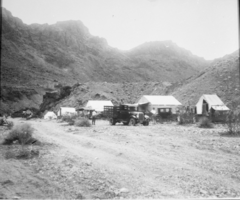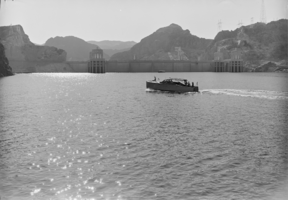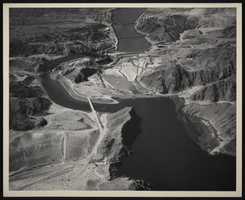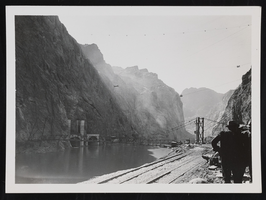Search the Special Collections and Archives Portal
Search Results
Morgan Mills oral history interview
Identifier
Abstract
Oral history interview with Morgan Mills conducted by Matthew Carr on March 26, 1981 for the Ralph Roske Oral History Project on Early Las Vegas. In this interview, Mills discusses being involved in major projects in the Las Vegas, Nevada area while he was living in California. Mills also discusses Boulder City, Nevada and Reno, Nevada. He later discusses his career as an electrical engineer, as well as working on the Hoover Dam (Boulder Dam).
Archival Collection
Clark Crocker oral history interview
Identifier
Abstract
Oral history interview with Clark Crocker conducted by Monica Lehman on March 3, 1978 for the Ralph Roske Oral History Project on Early Las Vegas. Crocker discusses his family and educational background as well as his experiences attending school in California and Massachusetts. Crocker then describes the building of the Hoover Dam and his career as a teacher and school principal, as well as his thoughts and philosophies on how curriculum should be structured in schools. Crocker also discusses his work for the fire department in Pahrump, Nevada and his career as a frogman and navigator for the United States Navy during World War II.
Archival Collection
Bill Armstrong oral history interview
Identifier
Abstract
Oral history interview with Bill Armstrong conducted by Anthony Robone on February 20, 1979 for the Ralph Roske Oral History Project on Early Las Vegas. In the interview, Armstrong discusses his time bootlegging in Kentucky before arriving in Las Vegas, Nevada, his involvement with the Las Vegas dealers, and the weather as it relates to other parts of the country. He also discusses the impacts of the work of Howard Hughes on the town, the construction of Hoover Dam, the above-ground atomic testing, the growth of Las Vegas and tourism, changes in gambling habits for the next generation, and the social and recreational activities of residents.
Archival Collection

Film transparency of Ragtown homes, Nevada, circa early 1930s
Date
Archival Collection
Description
Image
Lee Tilman oral history interviews
Identifier
Abstract
Oral history interviews with Lee Tilman conducted by Dennis McBride on February 06, 11, 13, 17, and 22; May 28; and July 09, 1996 for the Boulder City Library Oral History Project. In the interviews, Tilman discusses his birth in Gooding, Idaho in 1913, his early life, and his arrival to Las Vegas, Nevada in 1931. Tilman then talks about his experiences mining, milling, and ranching before moving to Las Vegas. While in Las Vegas, Tilman was involved with construction of Hoover Dam (Boulder Dam) and labor issues. Later, Tilman describes fishing and boating in the Colorado River, working at a duplex mine in Searchlight, Nevada, and working at the Las Vegas Ice House. Lastly, Tilman talks about influential Boulder City residents he knew, his children, and the Stratosphere Hotel and Casino.
Archival Collection

Film transparency of Lake Mead, circa late 1930s
Date
Archival Collection
Description
Image

Aerial photograph of Parker Dam, circa 1938-1940s
Date
Archival Collection
Description
Image
Mary Eaton oral history interview
Identifier
Abstract
Oral history interview with Mary Eaton conducted by Dennis McBride on November 15, 1986 for the Boulder City Library Oral History Project. Eaton joined her husband Bruce in Las Vegas, Nevada in 1932, soon after he found work at the Hoover Dam building site. Within months of her arrival, the couple welcomed their first child and moved to Boulder City, Nevada. In this interview, Eaton recalls the early community formed by the wives of the dam workers, the establishment of the Grace Community Church and the death of the church's first pastor, "Parson Tom" Stevenson. She discusses the beginning of the school system in Boulder City and her career as an educator, as well as her involvement in numberous community projects and groups including the hospital and the Rainbow Club for young women.
Archival Collection
Paul M. Lytle oral history interview
Identifier
Abstract
Oral history interviews with Paul M. Lytle conducted by Dennis McBride on March 08, 1996 for the Boulder City Library Oral History Project. In the interview, Lytle discusses his birth in Salt Lake City, Utah, his early life in Overton, Nevada, moving around the Southwest United States, and returning to Overton in the early 1930s to work with the Civilian Conservation Corps. Subjects Lytle also talks about in the interview include road and campsite construction at the Valley of Fire State Park, stories about associates and relatives, and being enlisted as a male nurse with the United States Army during World War II. Lastly, Lytle talks about the construction of an exhibit building at Hoover Dam (Boulder Dam) originally used as a headquarters for soldiers during World War II to protect the dam.
Archival Collection

Diversion inlet tunnels: photographic print
Date
Archival Collection
Description
Image
